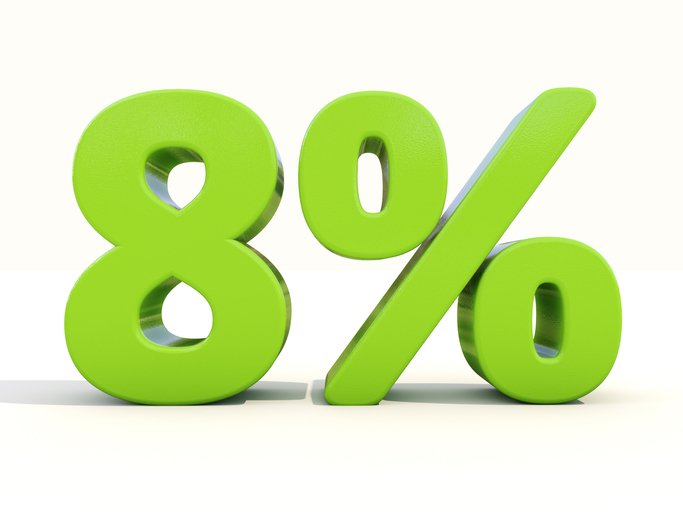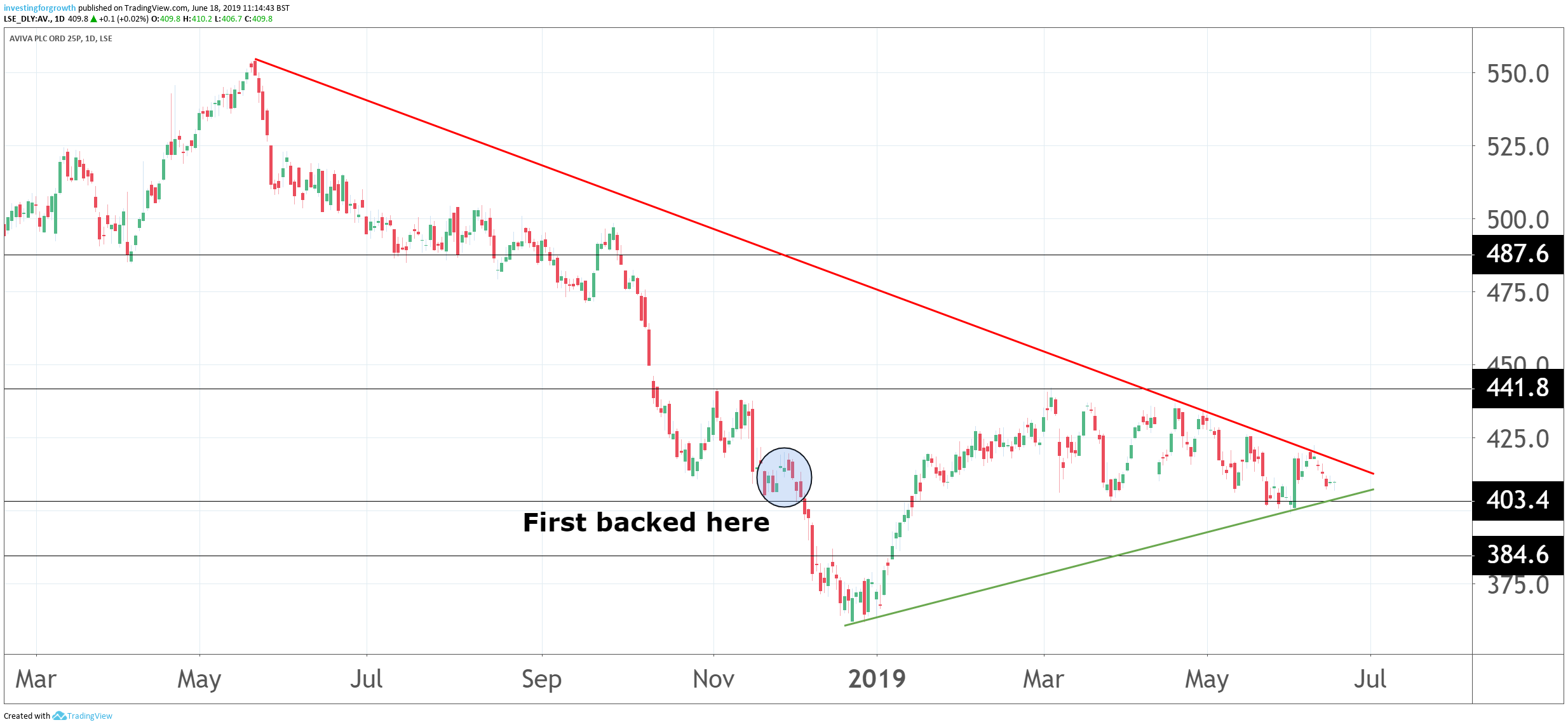Stockwatch: An 8% yield where risks are lower than feared
This blue-chip was first backed by our companies analyst last year. Here's what he thinks now.
18th June 2019 11:20
by Edmond Jackson from interactive investor
This high-yielding blue-chip was first backed by our companies analyst last year. Here's what he thinks now.

Is the 'buy' case I made for FTSE 100-listed insurer Aviva (LSE:AV.) last November at 410p, broadly intact?
Or, is this a typical example of a sideways-volatile share as the market becomes increasingly wary of financial stocks lest economies are headed for a downturn - higher risk means pricing equity for higher yield?
Aviva shares fell from a mid-2018 high of 530p, accelerated when financial stocks were hit last autumn in the market-wide sell-off, before recovering in the New Year to test 440p in March.
Since then the share price has bumped along and is currently back to 410p where it yields around 8%. That's on the basis that this year's dividend increases at the same rate as in 2018 when the payout rose 9.5% to 30p per share. If it does, it implies at least 32.5p this year, possibly nearer 33p.
I wouldn't rely on that, but I do still see reasons for it to grow. The dividend is in focus for Aviva's valuation for behavioural as well as fundamental reasons: a lot of income funds hold it, as do individuals seeking yield.

Source: TradingView Past performance is not a guide to future performance
"Progressive" dividend still implies upward-only
The stock dipped 3% in response to full-year results in March. It was blamed on the board switching from a fixed dividend policy to a progressive one, as if this meant payouts would become volatile if tied more closely to earnings.
I think it rather a neurotic response. The chairman indicated that the dividend will be at least maintained, or grown over time, according to business performance and prospects. And Maurice Tulloch, the CEO since March, has just recently declared in a 6 June investor update: "The sustainability and security of our dividend is paramount. We are focused on improving our performance to grow capital generation and cash flow."
Examining the 2018 cash flow statement, ordinary dividend payments rose 15% to over £1.1 billion (easily the chief outflow in dividends' context, relative to others going to different stakeholders). That's versus £6 billion generated from operations after tax, with £1 billion also going out to repay debt. Cash rose 7% to £46.6 billion at end-2019.
So, it would take a serious deterioration in life, health, general insurance and savings – Aviva listed in the Life Insurance sector, in terms of balance – to jolt a scenario of managed debt reduction together with progressive dividends.
You may not be able to assume perennial dividend growth, but even if the UK economy is more intensely tested by Brexit, Aviva's financial position suggests it can sustain a 30p per share payout in respect of 2019 and 2020.
Mind how statistical tables such as Company REFS (see below) cite 25.3p as the consensus dividend estimate as of last April, but also 24.3p historic in respect of 2017 when it was 27.4p (I've amended the table). Possibly, confusion arises because databases are inclined to calculate dividends on a payments' timing basis not what companies declare in respect of a financial year, but in terms of analysis I think the reported basis is appropriate. You're trying to compare suitability of payouts versus earnings and cash flow achieved in a financial year.
| Aviva - financial summary | Estimates | |||||
|---|---|---|---|---|---|---|
| year ended 31 Dec | 2014 | 2015 | 2016 | 2017 | 2018 | 2019 |
| IFRS3 pre-tax profit (£m) | 2,281 | 1,413 | 1,193 | 2,003 | 2,129 | |
| Normalised pre-tax profit (£m) | 2,420 | 1,730 | 1,383 | 2,193 | 1,267 | 1,989 |
| IFRS3 earnings/share (p) | 47.7 | 22.8 | 15.1 | 34.6 | 37.8 | |
| Normalised earnings/share (p) | 51.8 | 29.0 | 19.4 | 30.3 | 44.7 | 51.2 |
| Earnings per share growth (%) | 68.7 | -44.0 | -33.1 | 56.3 | 47.5 | 14.5 |
| Price/earnings multiple (x) | 9.3 | 8.0 | ||||
| Historic annual average P/E (x) | 16.2 | 9.9 | 15.2 | 26.4 | 16.3 | 8.6 |
| Dividend per share (p) | 18.1 | 20.8 | 23.3 | 27.4 | 30.0 | 25.3 |
| Dividend growth (%) | 14.9 | 12.0 | 17.6 | 9.5 | -15.7 | |
| Dividend yield (%) | 7.2 | 6.1 | ||||
| Covered by earnings (x) | 3.0 | 1.6 | 0.9 | 1.2 | 1.8 | 2.0 |
| Net tangible assets per share (p) | 423 | 414 | 438 | |||
| Source: Company REFS |
New CEO ought to improve odds of financial progress
In 2018, Aviva delivered a 7% rise in operating earnings per share (EPS) to 58.4p or 44.7p on a normalised basis. Obviously, the wider economy will be influential going forward, and any major insurer is exposed to a jolt in the financial system – say if Italy's fiscal situation finally blows up creating another eurozone crisis – given its investment activities to balance liabilities.
But, on a corporate level, a new boss since March has declared a mission to "reduce complexity, cost and duplication, enabling Aviva to be better at serving our customers and delivering stronger results for our shareholders."
I'm broadly positive about this, with two caveats: "streamlining Arriva" is hardly new as a corporate theme; and he's hardly a fresh perspective/pair of hands, having joined Aviva in 1992 becoming a director two years ago. More positively, the chairman has said: Maurice knows our strengths, where we need to improve and has a deep understanding of insurance and customers' needs...exceptionally well qualified to re-energise Aviva and deliver long-term growth."
Aviva's chief executive of six years, Mark Wilson, had made good progress tackling the sprawling under-performing beast created by his predecessor, and the £5.6 billion acquisition of Friends Life helped to mitigate balance sheet risk. But his restructuring was perceived as taking too long and Aviva should be delivering better.
Debt reduction of at least £1.5 billion by end-2022
The end-2018 accounts show bank debt reduced by £900 million to £9.4 billion, and £573 million of finance costs, relatively modest in a raft of other expenses that whittled pre-tax profit down to £1.6 billion.
Even so, finance costs remain chunky relative to profit, hence debt reduction as a current priority "saving approximately £90 million a year in interest expenses...builds on £1.4 billion debt repaid over the past two years...will further enhance our financial flexibility."
Possibly the market has lately had concern. If the financial environment worsens then Aviva's objective on debt may prevail at the expense of dividend growth, though I suggest an 8% yield – if at least maintained – is adequate compensation.
Shareholders ought really to welcome debt reduction as a priority because, if circa 30p a share in annual dividends is reasonably sustainable, then further de-risking the balance sheet should see equity value rise.
End-2018 net tangible assets were £13.4 billion equivalent, although my computation per share – after buybacks last year – is 348p versus 438p in the REFS' table above, factoring in acquired intangibles and goodwill. The stock is well-backed by assets on either view.
Cost cutting
The 6 June update introduces £300 million of costs to be cut over three years as another new element: reducing central office, contractor/consultant spending, project expenditure and other efficiencies – 1,800 jobs out of a total workforce of 30,000.
Logically it's somewhat uncomfortable – as if the previous six years' streamlining hadn't been enough and the chairman's seal of approval (one element behind my 'buy' stance last November) was less than insightful. Or insurance markets are getting tougher, hence more costs must be cut just to stand still. "Reducing Aviva's costs is essential to remain competitive..." says the CEO.
UK life and general insurance will be managed separately, with the digital direct business integrated into UK general "enabling stronger accountability and greater management focus on the UK's leading life and general insurance businesses."
Trading remains mixed
The assessment of Aviva now is quite similar to last year: "weaker performance in savings and asset management arising from lower investment markets, partly offset by growth in Europe and Asia together with our turnaround in Canada."
With some one-third of its profit generated overseas, Aviva isn't acutely exposed to Brexit risks, and I think the 8% yield prices in this mixed progress on trading. The chief risk remains what it always is for big insurance companies, that their investment operations are potentially affected by shifts in equity/bond markets, and manifestly there's concern about a cyclical peak. The current cycle has been extended long enough by central banks' stimulus and Trump's tax cuts.
Aviva's underlying improvements and overall risk/reward profile lead me to re-affirm by 'buy' stance at 410p, whether or not the macro context offers even better prices in due course. Averaging one's trades may help. Buy.
Edmond Jackson is a freelance contributor and not a direct employee of interactive investor.
These articles are provided for information purposes only. Occasionally, an opinion about whether to buy or sell a specific investment may be provided by third parties. The content is not intended to be a personal recommendation to buy or sell any financial instrument or product, or to adopt any investment strategy as it is not provided based on an assessment of your investing knowledge and experience, your financial situation or your investment objectives. The value of your investments, and the income derived from them, may go down as well as up. You may not get back all the money that you invest. The investments referred to in this article may not be suitable for all investors, and if in doubt, an investor should seek advice from a qualified investment adviser.
Full performance can be found on the company or index summary page on the interactive investor website. Simply click on the company's or index name highlighted in the article.
Disclosure
We use a combination of fundamental and technical analysis in forming our view as to the valuation and prospects of an investment. Where relevant we have set out those particular matters we think are important in the above article, but further detail can be found here.
Please note that our article on this investment should not be considered to be a regular publication.
Details of all recommendations issued by ii during the previous 12-month period can be found here.
ii adheres to a strict code of conduct. Contributors may hold shares or have other interests in companies included in these portfolios, which could create a conflict of interests. Contributors intending to write about any financial instruments in which they have an interest are required to disclose such interest to ii and in the article itself. ii will at all times consider whether such interest impairs the objectivity of the recommendation.
In addition, individuals involved in the production of investment articles are subject to a personal account dealing restriction, which prevents them from placing a transaction in the specified instrument(s) for a period before and for five working days after such publication. This is to avoid personal interests conflicting with the interests of the recipients of those investment articles.